4 Property from a Distinguished European Family Collection Marino Marini Cavaliere 1947 bronze 41 3/8 x 19 5/8 x 26 7/8 in. (105 x 50 x 68.3 cm) Incised "MM 1/0" on the base. Conceived in 1947, from an edition of 8 and cast during the artist's lifetime.
Provenance Private Collection, gift of the artist circa 1966 Thence by descent to the present owner Exhibited Rome, Palazzo Venezia, Mostra di Marino Marini 1966 (another example exhibited), no. 21 (illustrated) Venice, Centro di Cultura di Palazzo Grassi, Marino Marini Sculture, pitture, disegni dal 1914 al 1977, 1983 (another example exhibited), cat. no. 61, pl. XXVIII, p. 122 (illustrated) Literature Enzo Carli, Marino Marini Milan: Hoepli, 1950, pl. XXXII, cover (illustrated) Alfred Hentzen, Marino Marini exh. cat., Kestner Gesellschaft, Hannover and Kunstveirin Hamburg, 1951, pl. 13 (illustrated) Umbro Apollonio, Marino Marini Milan: Edizioni del Milione, 1953, pl. 83 (illustrated) Emile Langui, Marino Marini Cologne: Kiepenheurer & Witsch, 1954, pl. 16 (illustrated) Heinz Fuchs Marino Marini Il Miracolo, Stuttgart: Philipp Reclam, 1961 Mostra di Marino Marini exh. cat., Palazzo Venezia, Rome, 1966 (illustrated) Jiří Šetlík, Marino Marini Prague: Odeon, no. 24 (illustrated) Alberto Busignani, Marino Marini I maestri del Novecento, Florence: Sadea/Sansoni, 1968, no. 15 (illustrated) Herbert Read et al, Complete Works of Marino Marini New York: Tudor Publishing Co., 1970, p. 198, no. 230 (illustrated) Abraham Hammacher, Marino Marini Sculptures, Paintings, Drawings, New York: H. N. Abrams, 1970, p. 133 Carlo Pirovano, Marino Marini Scultore, Milan: Electa, 1972 p. 98 and pp. 104-105 (illustrated) Carlo Pirovano, Marino Marini Museo San Pancrazio, Milan: Electa, 1988, pp. 115-116 (illustrated) Carlo Pirovano, Marino Marini Bologna: Galleria Forni, 1990, p. 71 (illustrated) Sam Hunter Marino Marini The Sculpture, New York: H. N. Abrams, 1993, pp. 52-53 Ellen Maurer-Zilioli, Marino Marini Staatsgalerie moderner Kunst, Berlin: Hatje, 1997, p. 4 (illustrated) Marco Meneguzzo, Marino Marini Cavalli e cavalieri, Milan: Skira, 1997, no. 37, pp. 88-92 Giovanni Carandente, Marino Marini Catalogue Raisonné of the Sculptures, Milan: Skira, 1998, no. 302b, p. 212 (illustrated) Catalogue Essay "My equestrian statues express the torment caused by the events of this century. The restlessness of my horse grows with each new work, the rider appears increasingly worn out, he has lost his dominance over the beast and the catastrophes to which he succumbs are similar to those which destroyed Sodom and Pompeii." Marino Marini’s career was almost singularly focused on the investigation of the human condition as evinced by the relationship between the horse and his mount. Marini’s early explorations of the form exhibited the rounded modeling and harmonious union between man and beast that Marini so idolized in Etruscan sculpture. Prior to World War II, the relationship between horse and rider was a mutually beneficial symbiosis, yet, following the war, Marini’s faith in the direction of humanity was shaken to its core. By the 1950s, Marini’s horse and rider had become sharply angular forms, the rider more often than not in the process of being foisted from his perch. Marini ruptured this classical equilibrium and began to depict the rider as increasingly imperiled on his mount; the monumental solidity that characterized his earlier works is replaced by a sense of climax and crisis. What had been the embodiment of triumph and success – hardly is there a symbol more commanding than that of a commander astride his steed – was gradually transformed to an image of rupture, discord, and defeat. This Cavaliere, conceived in 1947, marks this pivotal turning point in Marini’s oeuvre. The forms of the horse and the rider still retain their rounded naturalism, but the rider turns up his head in anguish as his horse bends its head low to the ground in a gesture of defeat. Marini uses this potent imagery as a vehicle to convey his own disquiet about the human condition and about the direction in which he believed humanity was moving following the war. This particular iteration of Marini’s horse and rider was so prized by Marini’s patron, a
4 Property from a Distinguished European Family Collection Marino Marini Cavaliere 1947 bronze 41 3/8 x 19 5/8 x 26 7/8 in. (105 x 50 x 68.3 cm) Incised "MM 1/0" on the base. Conceived in 1947, from an edition of 8 and cast during the artist's lifetime.
Provenance Private Collection, gift of the artist circa 1966 Thence by descent to the present owner Exhibited Rome, Palazzo Venezia, Mostra di Marino Marini 1966 (another example exhibited), no. 21 (illustrated) Venice, Centro di Cultura di Palazzo Grassi, Marino Marini Sculture, pitture, disegni dal 1914 al 1977, 1983 (another example exhibited), cat. no. 61, pl. XXVIII, p. 122 (illustrated) Literature Enzo Carli, Marino Marini Milan: Hoepli, 1950, pl. XXXII, cover (illustrated) Alfred Hentzen, Marino Marini exh. cat., Kestner Gesellschaft, Hannover and Kunstveirin Hamburg, 1951, pl. 13 (illustrated) Umbro Apollonio, Marino Marini Milan: Edizioni del Milione, 1953, pl. 83 (illustrated) Emile Langui, Marino Marini Cologne: Kiepenheurer & Witsch, 1954, pl. 16 (illustrated) Heinz Fuchs Marino Marini Il Miracolo, Stuttgart: Philipp Reclam, 1961 Mostra di Marino Marini exh. cat., Palazzo Venezia, Rome, 1966 (illustrated) Jiří Šetlík, Marino Marini Prague: Odeon, no. 24 (illustrated) Alberto Busignani, Marino Marini I maestri del Novecento, Florence: Sadea/Sansoni, 1968, no. 15 (illustrated) Herbert Read et al, Complete Works of Marino Marini New York: Tudor Publishing Co., 1970, p. 198, no. 230 (illustrated) Abraham Hammacher, Marino Marini Sculptures, Paintings, Drawings, New York: H. N. Abrams, 1970, p. 133 Carlo Pirovano, Marino Marini Scultore, Milan: Electa, 1972 p. 98 and pp. 104-105 (illustrated) Carlo Pirovano, Marino Marini Museo San Pancrazio, Milan: Electa, 1988, pp. 115-116 (illustrated) Carlo Pirovano, Marino Marini Bologna: Galleria Forni, 1990, p. 71 (illustrated) Sam Hunter Marino Marini The Sculpture, New York: H. N. Abrams, 1993, pp. 52-53 Ellen Maurer-Zilioli, Marino Marini Staatsgalerie moderner Kunst, Berlin: Hatje, 1997, p. 4 (illustrated) Marco Meneguzzo, Marino Marini Cavalli e cavalieri, Milan: Skira, 1997, no. 37, pp. 88-92 Giovanni Carandente, Marino Marini Catalogue Raisonné of the Sculptures, Milan: Skira, 1998, no. 302b, p. 212 (illustrated) Catalogue Essay "My equestrian statues express the torment caused by the events of this century. The restlessness of my horse grows with each new work, the rider appears increasingly worn out, he has lost his dominance over the beast and the catastrophes to which he succumbs are similar to those which destroyed Sodom and Pompeii." Marino Marini’s career was almost singularly focused on the investigation of the human condition as evinced by the relationship between the horse and his mount. Marini’s early explorations of the form exhibited the rounded modeling and harmonious union between man and beast that Marini so idolized in Etruscan sculpture. Prior to World War II, the relationship between horse and rider was a mutually beneficial symbiosis, yet, following the war, Marini’s faith in the direction of humanity was shaken to its core. By the 1950s, Marini’s horse and rider had become sharply angular forms, the rider more often than not in the process of being foisted from his perch. Marini ruptured this classical equilibrium and began to depict the rider as increasingly imperiled on his mount; the monumental solidity that characterized his earlier works is replaced by a sense of climax and crisis. What had been the embodiment of triumph and success – hardly is there a symbol more commanding than that of a commander astride his steed – was gradually transformed to an image of rupture, discord, and defeat. This Cavaliere, conceived in 1947, marks this pivotal turning point in Marini’s oeuvre. The forms of the horse and the rider still retain their rounded naturalism, but the rider turns up his head in anguish as his horse bends its head low to the ground in a gesture of defeat. Marini uses this potent imagery as a vehicle to convey his own disquiet about the human condition and about the direction in which he believed humanity was moving following the war. This particular iteration of Marini’s horse and rider was so prized by Marini’s patron, a

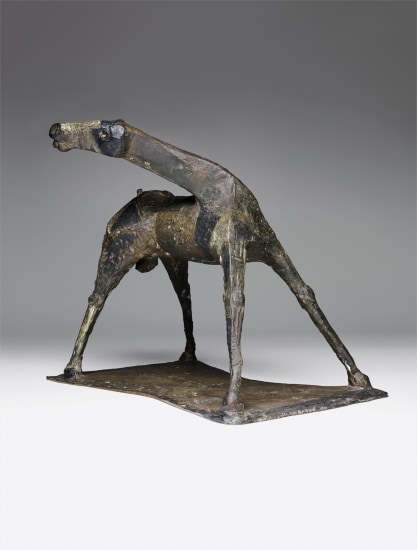
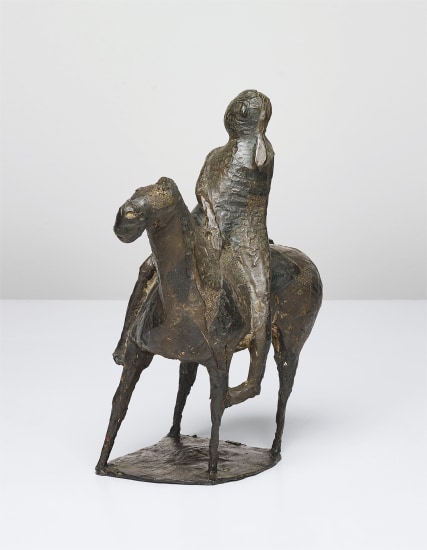

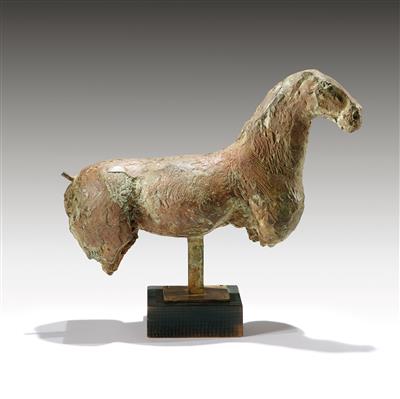
.jpg)

.jpg)
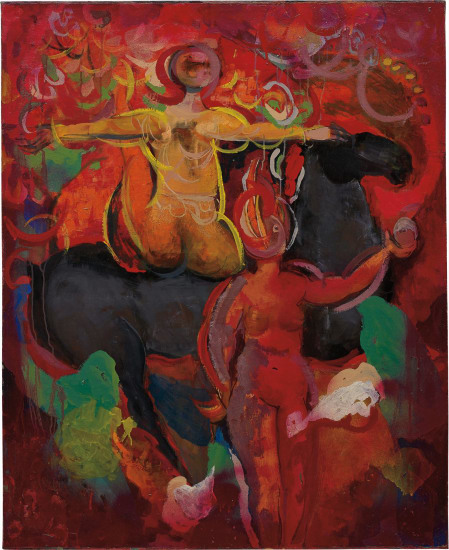
.jpg)
.jpg)


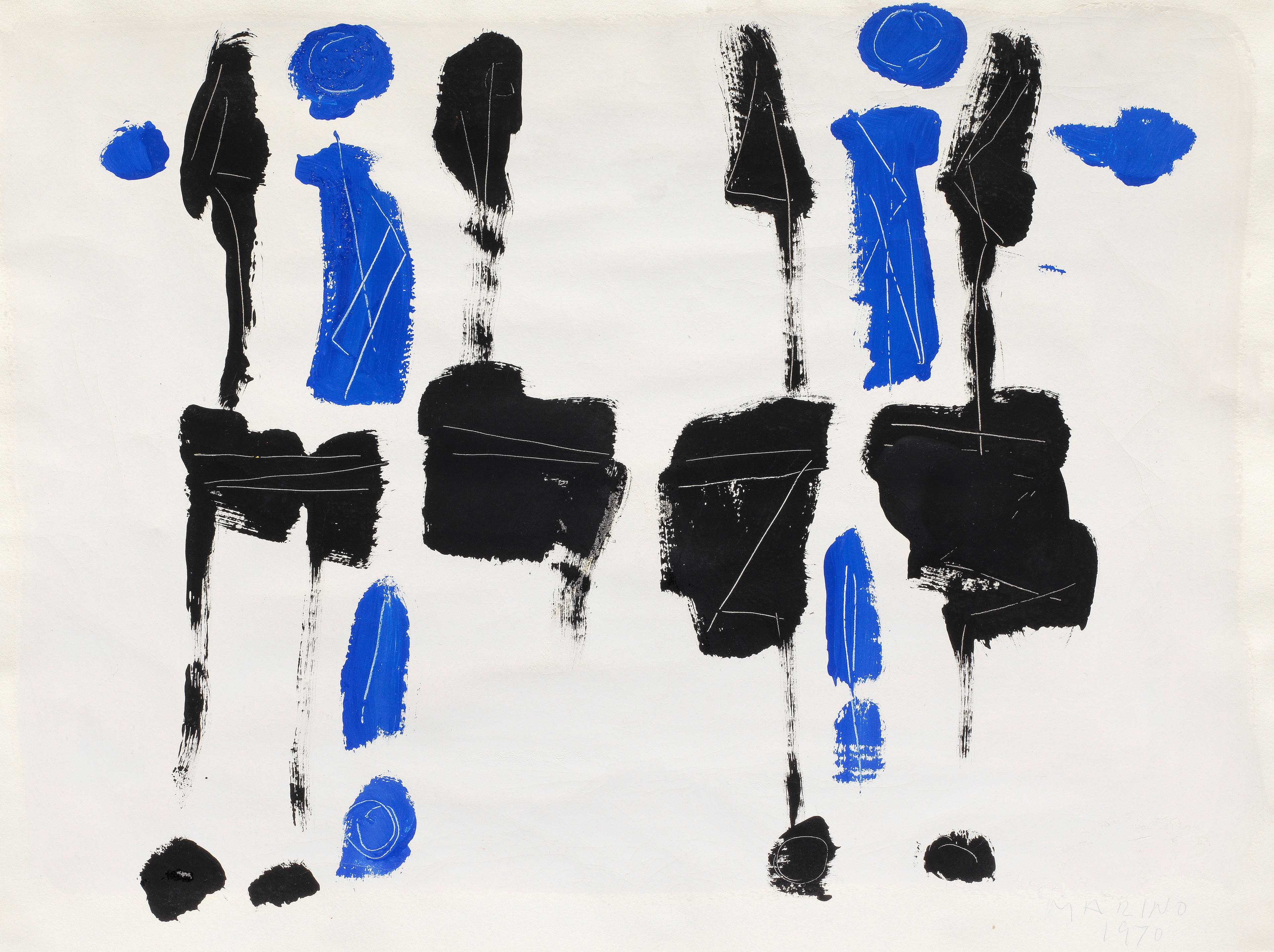
Testen Sie LotSearch und seine Premium-Features 7 Tage - ohne Kosten!
Lassen Sie sich automatisch über neue Objekte in kommenden Auktionen benachrichtigen.
Suchauftrag anlegen